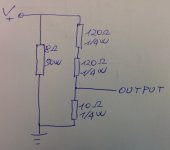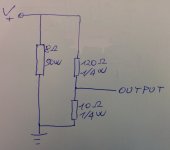I built a clone of a 18W Marshall following the layout on Ceriatone. Sometimes I play during night, but because of the noise of the amp I have to play unplugged. Do you know how can I connect my Headphones in the right way not to damage the amp?
I know there could be noise or not good audio, but I don't care
I know there could be noise or not good audio, but I don't care
^^^^^^^ I wouldn't think this is the proper way to do it for a tube amp. It will incorrectly load the power tubes.
I would use a 50 watt 8 ohm dummy load. Then parallel the dummy load with a couple of series resistors 120R on the hot side and 10R on the ground side. Feed the attenuated signal (the junction between 120R and 10R) to some sort of opamp based battery power amplifier like a Cmoy. That should be able to drive any headphones.
http://www.amazon.com/Amico-Aluminum-Housed-Wirewound-Resistor/dp/B0087ZCYD6
I would use a 50 watt 8 ohm dummy load. Then parallel the dummy load with a couple of series resistors 120R on the hot side and 10R on the ground side. Feed the attenuated signal (the junction between 120R and 10R) to some sort of opamp based battery power amplifier like a Cmoy. That should be able to drive any headphones.
http://www.amazon.com/Amico-Aluminum-Housed-Wirewound-Resistor/dp/B0087ZCYD6
Last edited:
I can't see any harm from loading an amp with higher than usual impedance. It's an easier load to drive for the output tubes. Perhaps i overlook something?
In that amp the EL84's get a 8K plate to plate impedance. If you use that pages recommendations on resistor values you would end up with a 300k plate to plate impedance.
Again, I can't see any harm from loading an amp with higher than usual impedance.
Especially tubes like higher impedance load, no?
Anyway, i don't think the OPT primary inductance would allow 300k Zpp.
Especially tubes like higher impedance load, no?
Anyway, i don't think the OPT primary inductance would allow 300k Zpp.
Bad idea, you run the risk of damaging output transformer, tubes, and sockets.
Care to explain how?
Same reason it's a really bad idea to run a tube amp without a speaker connected, especially in a guitar amp because they are usually driven much harder.
Anyway the way I see it is the increased AC voltage swing developed in the output transformer can and will arc if the rating is exceeded.
Anyway the way I see it is the increased AC voltage swing developed in the output transformer can and will arc if the rating is exceeded.
^^^^^^^ I wouldn't think this is the proper way to do it for a tube amp. It will incorrectly load the power tubes.
I would use a 50 watt 8 ohm dummy load. Then parallel the dummy load with a couple of series resistors 120R on the hot side and 10R on the ground side. Feed the attenuated signal (the junction between 120R and 10R) to some sort of opamp based battery power amplifier like a Cmoy. That should be able to drive any headphones.
Amazon.com: Amico 50 Watt 8 Ohm 5% Aluminum Housed Wirewound Power Resistor Gold Tone: Automotive
thank you for your help. What happens if I don't put a Cmoy?
I think building (or buying) something small and battery powered (LM386?) would do the job. Ideal for couch-playing late at night.
Or buy a 2nd hand line6 pocket-pod.
YMMV
Or buy a 2nd hand line6 pocket-pod.
YMMV
I think building (or buying) something small and battery powered (LM386?) would do the job. Ideal for couch-playing late at night.
Or buy a 2nd hand line6 pocket-pod.
YMMV
Now I have an mc33174 already available. Can I use it?
Now I have an mc33174 already available. Can I use it?
I'm afraid not, since that's an opamp, not suitable to drive low-impedance loads like a headphone.
For LM386 guitar amps see here: http://www.beavisaudio.com/projects/NoisyCricket/
Last edited:
You have one too many 120 ohm resistors in your diagram.
Are you looking to play cleanly? Or do you want to have that cranked Marshall amp sound? That half a watt LM386 amp will still be somewhat loud with a guitar cab or speaker.
Basically what I did was step down the MAX volume 12Vrms from the Marshall to a normal line level 1Vrms so you can use whatever you want to drive your headphones. If you find you need more than 1Vrms you can replace the 10 ohm resistor with a 22 ohm resistor and you will get 2Vrms with your Marshall maxed to 11😉 The reason I suggested the Cmoy was because I do not feel that most modern headphone manufacturers adhere to that 120R guideline anymore, most are made for a voltage source of very low output impedance, typically <1 ohm. If you have a home stereo with a headphone output try plugging in the attenuated signal from the Marshall to any line level input before building anything.
Are you looking to play cleanly? Or do you want to have that cranked Marshall amp sound? That half a watt LM386 amp will still be somewhat loud with a guitar cab or speaker.
Basically what I did was step down the MAX volume 12Vrms from the Marshall to a normal line level 1Vrms so you can use whatever you want to drive your headphones. If you find you need more than 1Vrms you can replace the 10 ohm resistor with a 22 ohm resistor and you will get 2Vrms with your Marshall maxed to 11😉 The reason I suggested the Cmoy was because I do not feel that most modern headphone manufacturers adhere to that 120R guideline anymore, most are made for a voltage source of very low output impedance, typically <1 ohm. If you have a home stereo with a headphone output try plugging in the attenuated signal from the Marshall to any line level input before building anything.
Attachments
Here are the specs of my headphones: Sennheiser RS 120 II - Audio Headphones Stereo Wireless - Ideal for modern music & TV - Lightweight
I want to mantain that cranked marshall sound, if possible.
And then I wire the LM386 in a normal Cmoy? I used this circuit for the cmoy: http://tangentsoft.net/audio/cmoy/misc/cmoy-tangent-sch.pdf
I want to mantain that cranked marshall sound, if possible.
And then I wire the LM386 in a normal Cmoy? I used this circuit for the cmoy: http://tangentsoft.net/audio/cmoy/misc/cmoy-tangent-sch.pdf
You probably don't even need a headphone amp because those look to already be powered. Just connect the attenuated output of the Marshall to your headphone transmitter and you should be good to go. So all you need is 3 resistors and a shielded cable terminated with whatever connector you use to hook into the headphone transmitter.
Easy peasy
Easy peasy
You probably don't even need a headphone amp because those look to already be powered. Just connect the attenuated output of the Marshall to your headphone transmitter and you should be good to go. So all you need is 3 resistors and a shielded cable terminated with whatever connector you use to hook into the headphone transmitter.
Easy peasy
ok thank you very much 😉
- Status
- Not open for further replies.
- Home
- Live Sound
- Instruments and Amps
- Headphones on 18W Marshall

